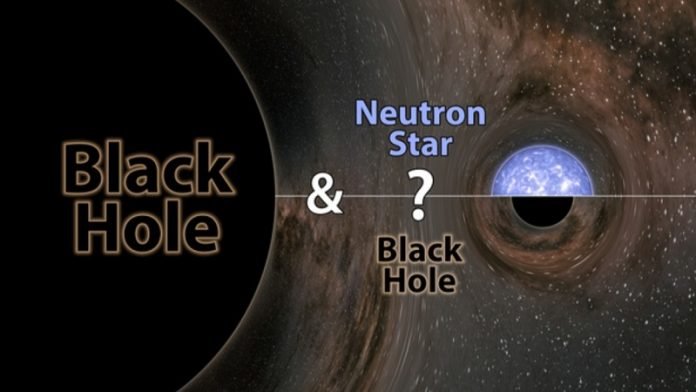
In August of 2019, the LIGO-Virgo gravitational-wave network witnessed the merger of a black hole with 23 times the mass of our sun and a mystery object 2.6 times the mass of the sun.
Scientists do not know if the mystery object was a neutron star or black hole, but either way it set a record as being either the heaviest known neutron star or the lightest known black hole.
A black hole around 23 times the size of the Sun has swallowed a mysterious, much smaller astrophysical object, according to new research announced by the LIGO and Virgo gravitational wave observatories.
The gravitational waves from this surprising event were detected by the LIGO and Virgo detectors on 14 August 2019 with the signal coming from a distance of around 800 million light years.
Researchers think the mystery object is most likely either the lightest black hole or possibly the heaviest neutron star ever discovered.
Neutron stars are formed during the explosion of a giant star and are the smallest and densest type of star in the Universe.
But the object’s mass makes it especially “intriguing”.
“There is a mass gap between the mass of known neutron stars which are less massive and black holes which are more massive,” Professor Susan Scott from the ANU Research School of Physics said.
“This object falls within that mass gap, making it either the heaviest neutron star or the lightest black hole ever discovered.”
The mass of the mysterious object, at 2.6 solar masses, is similar to that of the object formed from the first ever observation by LIGO and Virgo in 2017 of two neutron stars colliding, which is thought to be a black hole.
The ANU SkyMapper Telescope scanned the area of space where the event occurred, but couldn’t find any visual clues.
“Finding light from this event would have been the smoking gun that proved we had just made the first ever observation of the merger of a black hole with a neutron star,” Professor Scott said, who is also Leader of the General Relativity Theory and Data Analysis Group at ANU and a Chief Investigator with the ARC Centre of Excellence for Gravitational Wave Discovery (OzGrav).
“But due to the very unequal masses of the colliding objects and because this event was so far away, the absence of any visual clues is consistent with either a binary black hole merger or the merger of a black hole with a neutron star.”
The ‘ripples’ from the event also add further weight to a well-known scientific theory, according to OzGrav postdoctoral researcher Dr Terry Mcrae from ANU.
“The theory of general relativity predicts changes in the gravitational waves produced when very different sized objects are involved in the collision. This event confirms that prediction,” Dr Mcrae said.
“This further cements general relativity as the most successful theory in physics of the modern era.”



